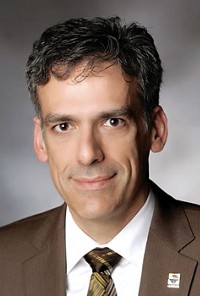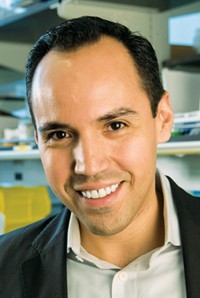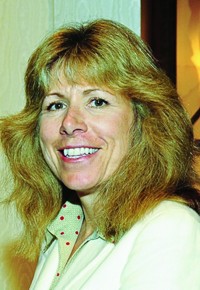Advertisement
Grab your lab coat. Let's get started
Welcome!
Welcome!
Create an account below to get 6 C&EN articles per month, receive newsletters and more - all free.
It seems this is your first time logging in online. Please enter the following information to continue.
As an ACS member you automatically get access to this site. All we need is few more details to create your reading experience.
Not you? Sign in with a different account.
Not you? Sign in with a different account.
ERROR 1
ERROR 1
ERROR 2
ERROR 2
ERROR 2
ERROR 2
ERROR 2
Password and Confirm password must match.
If you have an ACS member number, please enter it here so we can link this account to your membership. (optional)
ERROR 2
ACS values your privacy. By submitting your information, you are gaining access to C&EN and subscribing to our weekly newsletter. We use the information you provide to make your reading experience better, and we will never sell your data to third party members.
Biological Chemistry
Nanoscale Focus
Scientists at UCLA’s California NanoSystems Institute emphasize eliminating boundaries in research
by Rudy M. Baum
March 12, 2012
| A version of this story appeared in
Volume 90, Issue 11
Members of the California NanoSystems Institute (CNSI) sometimes seem to be less interested in the nanoscale, per se, than they are in what it takes to work successfully on nanoscale problems.
It’s not that they aren’t passionate about their research on the chemistry, physics, biology, and engineering issues of nanoscale systems. They are. But what comes out most prominently in conversations with CNSI members is the centrality of collaboration, of bringing disparate disciplines together to achieve success in nanoscale research.
“There is no dividing line between the scientific disciplines at CNSI,” says Paul S. Weiss, a chemistry professor at the University of California, Los Angeles, and director of CNSI. “We push the fundamental science. We’ve gotten rid of the boundaries for people who want to work in that way. If people want to see what applications there are for chemistry, for example, in medicine or diagnostics or electronics or anywhere else, then they have an opportunity to do that here. We have a very high level of stimulation from all sides at all times.”
“This institute brings together science, engineering, and medicine,” says Richard B. Kaner, a UCLA chemistry professor and former associate director of CNSI. “UCLA is unique in that our medical school is on the university’s main campus. From CNSI, the chemistry department is 50 yards in one direction, engineering is 50 yards in another direction, and the medical school is 50 yards in a third direction. CNSI serves as the nexus among these three areas.
“Let me give you one example,” Kaner says. “Eric Hoek, who is a professor of civil and environmental engineering, listened to one of my lunch seminars on conducting polymer materials. Afterward he asked me, ‘So you can really make membranes out of conducting plastic?’ Yes, we can. He studies water separations, and he had always wanted to make a conducting membrane you could put a field across and control what goes in and out.” The lunchtime meeting, Kaner says, led to a collaboration with industrial support with the goal of building an artificial kidney.
“This institute brought together a civil engineer and a chemist to build membranes, and although we may never make an artificial kidney, we’ve discovered many interesting membrane properties that are leading to applications in filtration and water separation.”
CNSI was founded in 2000 as one of four Governor Gray Davis Institutes for Science & Innovation. Its stated goal, with its partner institute at UC Santa Barbara, Weiss says, is to “foster the commercial translation of new innovations in science and technology and to drive entrepreneurial growth, to create jobs, and to expand the California economy into new industries and markets. We have a self-selected group of faculty, 120 from 29 departments, whom I think of as the curious ones.” Weiss points out that although the 120 members of CNSI represent only about 2% of UCLA’s total faculty, in the past two years 30% of all UCLA invention disclosures were reported by CNSI members, one-third of all UCLA U.S. patents issued included CNSI members, and half of all new start-up companies at UCLA involved CNSI researchers. Since 2007, more than 300 new jobs were created by CNSI-related start-up companies.
CNSI members collectively represent more than $140 million in annual research grants, Weiss says, about 12% of which comes from industry and foundations and the rest from federal agencies. “We also have support from the UC system that goes to all Governor Gray Davis Institutes, as well as substantial extra support from UCLA,” he says.
One of the strengths of CNSI, Weiss says, is its core user facilities focusing on electron microscopy, optical microscopy for life and materials sciences, scanning-probe microscopy, materials growth, nanofabrication, and high-throughput screening. Each has its own faculty director, a CNSI member who is responsible for the overall vision for the facility, and a scientific director and staff to train users and to run the day-to-day operations of the facility. Through these facilities, CNSI members look to the future to identify tools that will need to be developed to continue to advance nanoscience and nanotechnology.
James K. Gimzewski is the faculty director of the Nano & Pico Characterization Lab core facility and a professor in UCLA’s department of chemistry and biochemistry. He came to CNSI in 2000 after a career in research at IBM and expresses the same impatience with traditional disciplinary boundaries that characterize Weiss’s and Kaner’s comments.
“At IBM, we didn’t care whether it was chemistry, physics, or anything else. We did a lot of nice, blue-sky stuff,” Gimzewski says. “In so much of academia, what you see is the chemistry department separated from the physics department, everything with borders, everybody in the trenches, occasionally sticking their heads up and calling it collaborative research.
“The concept of CNSI was one of the things that brought me here, the opportunity to do truly interdisciplinary research. I think there are many different models for nanosystems institutes. The essential thing about CNSI is that it is more like a corporate research laboratory.”
Like Kaner, Gimzewski points to the proximity and size of UCLA’s medical school as an important component of CNSI. “I tried to work with medical people in the past,” he says. “People didn’t have the time. But there are so many people here, young people, and they are eager to try new things. You are able to strike up really good collaborations.”
André E. Nel is a professor of medicine at UCLA and the director of CNSI’s Center for the Environmental Implications of Nanotechnology; he’s also the director of the UC Nanotoxicology Research & Training Program. “Nanomedicine is making use of nanomaterials to impact diagnosis, imaging, and therapeutics in a unique way,” Nel says. “The advent of nano has the potential to bring a new order of thinking into medicine, not just new technology.
“I think the impact of nano is that it has shown medicine that multidisciplinary research that has a physical-chemical dimension and an engineering approach allows you to make new discoveries that you could not make if you only thought at the level of a biologist,” Nel says.
Anne M. Andrews is a CNSI member whose entire career has been at the intersection of chemistry and medicine. “I’m a chemist by training,” Andrews says. “My Ph.D. was in chemistry, and my first faculty appointment was in the chemistry department at Penn State. But for the past 20 years I’ve been studying brain chemistry associated with anxiety and depression. So it’s a very specialized type of chemistry and not one that fits very easily into typical academic structures.”
Andrews says that she has spent her career “trying to see where I might fit in.” At Penn State, she moved from the chemistry department to the department of veterinary and biomedical sciences. “That was a little better fit,” she says, but the focus of research in the department was immunology and toxicology, not neuroscience. In 2009, Andrews and Weiss (they’re married) moved from Penn State to UCLA, where Weiss took over as director of CNSI. “The move has been great for Paul,” Andrews says, “but it’s been absolutely excellent for me, too.”
At UCLA, Andrews joined the department of psychiatry in the medical school. “There are more than 300 neuroscientists at UCLA,” she says. “In the medical school, you’re your own small-business enterprise. No one really cares so much whether you fit or not as long as you’re successful.”
Andrews’ research falls into three areas, she says. About a third is focused on “developing and using physical-analytical methods to study brain chemistry. We develop, build, and use devices to actually get into the brain and make measurements of serotonergic neurotransmission as it is happening.” Another third is focused on systems neuroscience using neuropharmacology to probe brain function. The final third, and the portion most relevant to CNSI, is a collaboration with Weiss to develop sensors that probe in vivo neurochemistry of single neurons, in real time.
Andrews echoes other members of CNSI on the importance of abolishing boundaries. “I believe that departmental distinctions are artificial and have nothing to do with what the natural world really represents. They have very little to do with the important problems that need to be solved today. Institutes like CNSI that focus more broadly and include scientists from a variety of fields will be the kinds of places where the best science is done.”







Join the conversation
Contact the reporter
Submit a Letter to the Editor for publication
Engage with us on Twitter